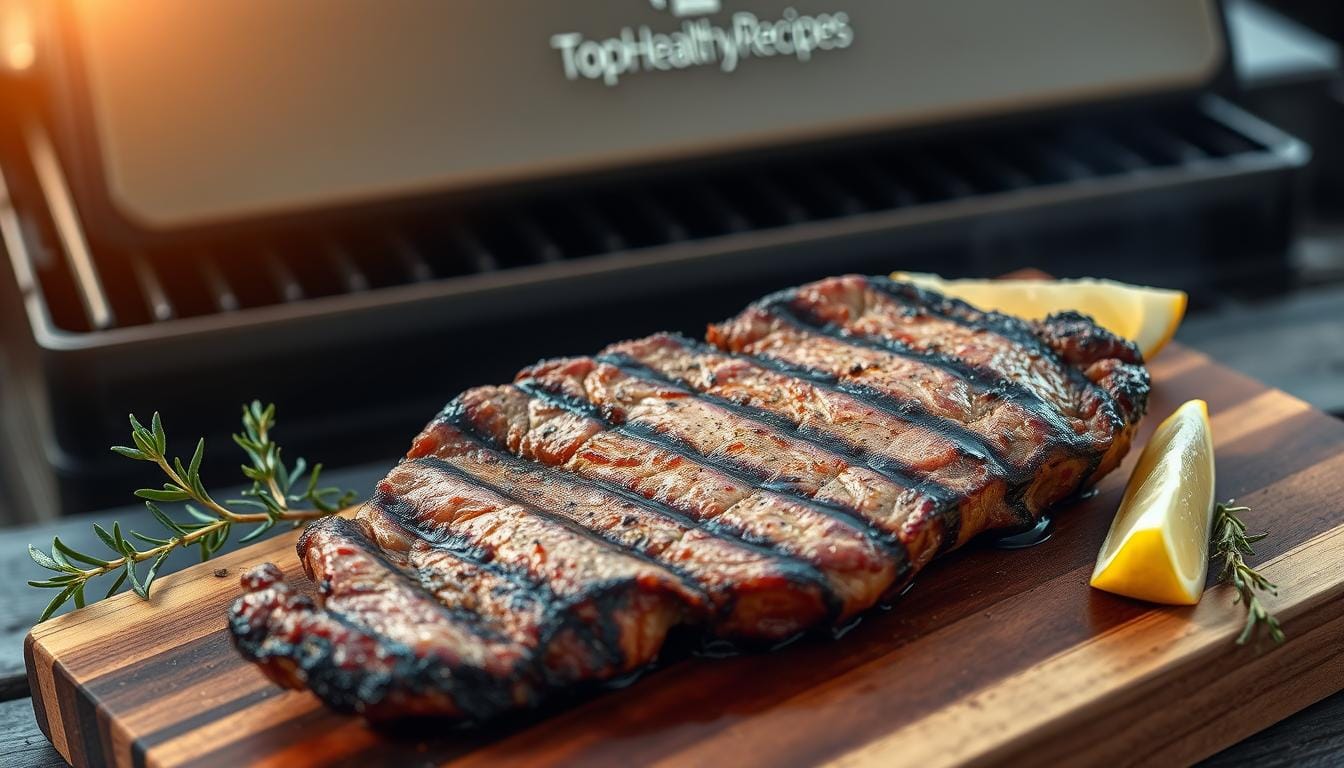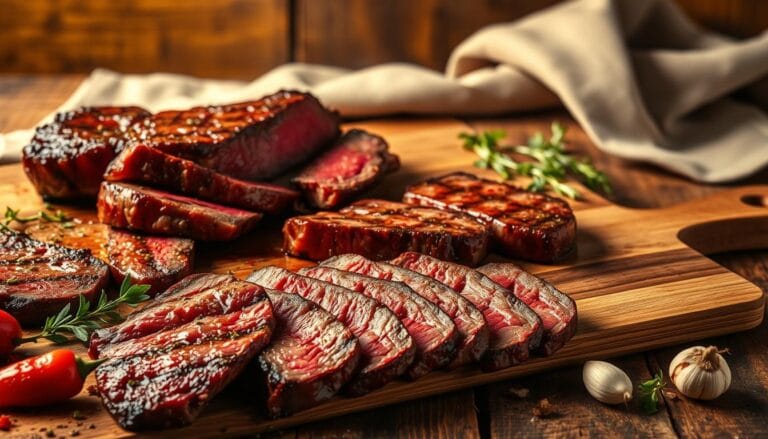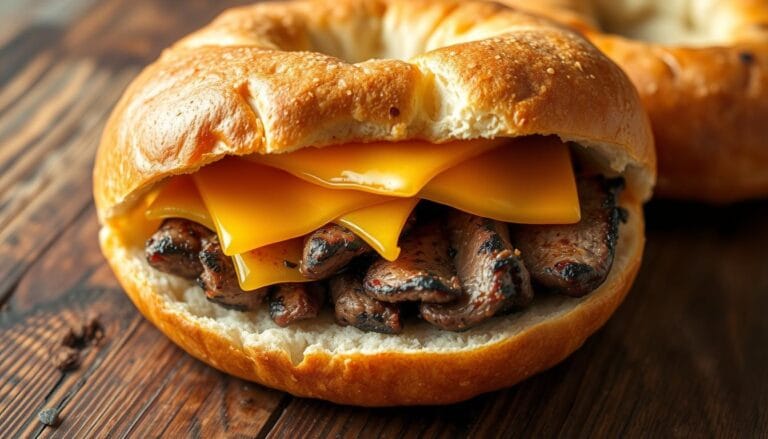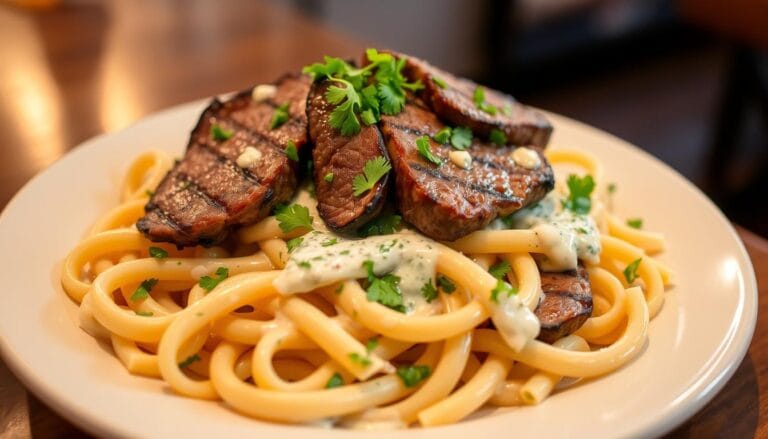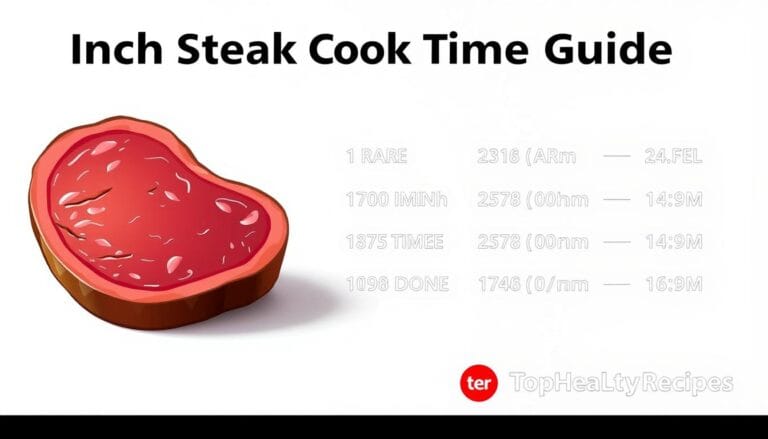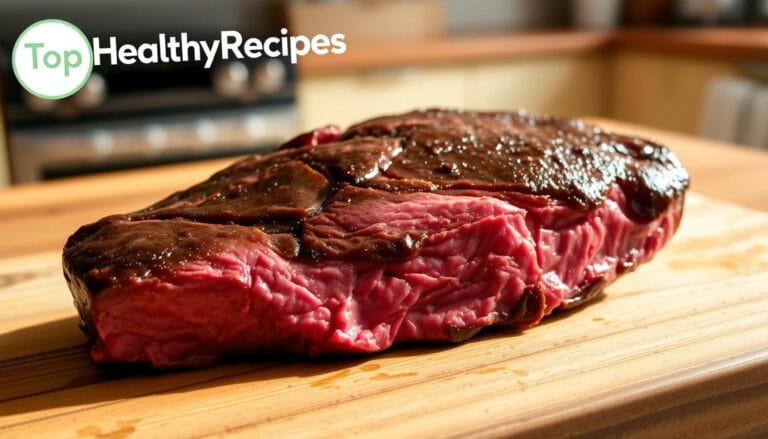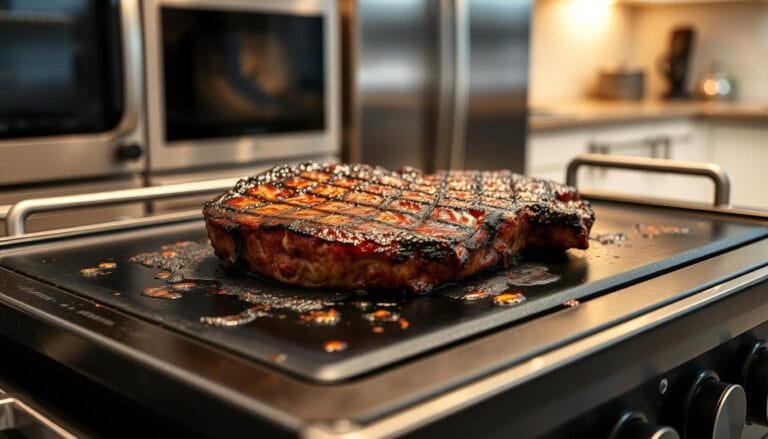How to Grill Strip Steak to Perfection Every Time
Table of Contents
How to Grill Strip Steak to Perfection Every Time
There’s something special about the first sizzle when meat hits the grill. The smoky smell and golden lines that form are amazing. But, watching a beautiful cut turn tough or unevenly cooked can be frustrating.
Mastering the NY strip isn’t about fancy tools or secret rituals. It’s about understanding three non-negotiable truths: heat management, patience, and trusting your senses. Whether you’re using charcoal or gas, the principles are the same. This cut, with its bold marbling and robust flavor, deserves more than guesswork.
Remember your last backyard cookout? Did your steak shine as the star, with a crusty outside and juicy inside? Or did it take a backseat to the sides? The difference is in the details: how you dry the steak, when you season it, and why resting is as important as cooking.
Key Takeaways
- Select NY strip steaks with visible marbling for optimal flavor and tenderness
- Preheat your grill 15-20 minutes before cooking for consistent searing
- Use the finger test or meat thermometer to gauge doneness accurately
- Let cooked meat rest 5-8 minutes to redistribute juices
- Season generously with kosher salt just before grilling
- Keep grill tools handy: tongs, instant-read thermometer, and resting plate
Understanding Strip Steak: What Makes It Special
The New York strip steak is a top choice for a steakhouse-quality meal at home. It’s cut from the short loin primal, between the tenderloin and rib sections. This gives it a unique mix of texture and flavor.
Key Characteristics of Strip Steak
The New York strip steak, also known as a Kansas City strip, is known for its long, narrow shape. It has a fat cap along one edge. Unlike the ribeye, it has moderate intramuscular fat in thin streaks.
This fat melts during grilling, keeping the meat juicy. It’s not too greasy. The steak is firmer than filet mignon but not as chewy as flank steak. It’s perfect for those who want tenderness and substance.
Ideal Cut for Grilling
Grill masters love the strip steak because it’s thick (1–1.5 inches). This thickness allows for a crispy crust and a tender inside. The fat cap bastes the meat, adding flavor without needing constant flipping.
It’s leaner than ribeye, so it has fewer flare-ups. It’s also forgiving for beginners and seasoned grillers. It won’t dry out quickly, even if you’re new to temperature control.
Flavor Profile and Tenderness
The strip steak has a bold, beefy flavor with nutty undertones. Its marbling keeps each bite moist. The muscle structure gives a satisfying chew.
When cooked to medium-rare (130–135°F), it’s at its peak tenderness. It slices easily against the grain. It’s a perfect middle ground between ribeye and filet mignon.
Choosing the Right Strip Steak
Finding the perfect strip steak is more than just picking the first one you see. The right choice affects the taste, juiciness, and how well you can cook NY strip steak. Let’s look at three key factors that make a steak stand out.
Grass-Fed vs. Grain-Fed: Taste and Ethics
Grass-fed beef comes from cows that eat grass, while grain-fed ones eat corn or soy. Here’s what it means for your steak:
- Grass-fed: Leaner, earthy flavor, more omega-3s
- Grain-fed: More marbling, buttery taste, easy to find
Choosing ethically sourced meat is also important. Look for labels like “Animal Welfare Approved” or “Global Animal Partnership” if you care about animal welfare.
Decoding USDA Beef Grades
The USDA grades beef based on marbling and maturity. More marbling means a juicier steak when you cook NY strip steak.
| Grade | Marbling Level | Best For |
|---|---|---|
| Prime | Abundant | Special occasions |
| Choice | Moderate | Everyday grilling |
| Select | Minimal | Marinated dishes |
Selecting the Ideal Thickness
Thicker cuts (1.25-1.5 inches) are better for controlling doneness. They allow for a crispy crust without overcooking the inside. Thin steaks (under 1 inch) cook too fast, making it hard to get the right temperature.
Always check these freshness indicators:
- Color: Bright cherry-red (not brown or gray)
- Texture: Firm to the touch
- Smell: Clean, slightly metallic aroma
Pro tip: Ask your butcher to cut steaks to your preferred thickness. This ensures consistent results every time you fire up the grill.
Essential Grilling Tools You’ll Need
Grilling strip steak is more than just skill—it’s about the right tools. The right gear makes your process smoother, enhances flavor, and prevents common mistakes. Here’s what you need for top-notch steak at home.
Grill Types: Gas vs. Charcoal
Gas grills start quickly and control temperature well, great for beginners. They’re perfect for those who want to focus on timing and seasoning without flare-ups. Charcoal grills, on the other hand, offer unmatched smoky flavor. They sear steaks beautifully but require attention to airflow and coal placement.
“Charcoal adds depth to your steak’s crust, while gas gives consistency. Choose based on your priorities: convenience or flavor.”
Recommended Utensils for Grilling
Here are the must-haves:
- Long-handled tongs: Keep control and avoid burns when flipping steaks
- Stiff-bristle grill brush: Clean grates well before cooking
- Drip pans: Reduce flare-ups from rendered fat
- Cut-resistant gloves: Handle hot tools and meat safely
Using a Meat Thermometer
Don’t guess the doneness of your steak. Digital instant-read thermometers give quick and accurate readings. Analog models are cheaper but might be off by 5-10°F. For the best results:
| Doneness Level | Internal Temp |
|---|---|
| Rare | 120-125°F |
| Medium-Rare | 130-135°F |
| Medium | 140-145°F |
Insert the probe sideways into the steak’s thickest part for reliable readings. Let the thermometer do the work so you can focus on grill management.
Preparing Your Strip Steak for the Grill
Getting your New York strip steak ready is key to making it juicy and restaurant-quality. Whether you’re sticking to a classic recipe or trying new flavors, these steps help your steak cook evenly. They also keep its natural richness intact.
Seasoning Options: Simple vs. Complex
Don’t skip the salt—it’s essential for flavor. Use ½ teaspoon of kosher salt per pound of steak and press it into the meat. For a simple taste, just use coarse salt and black pepper.
If you want more flavor, mix smoked paprika, garlic powder, and brown sugar. This blend adds depth to your steak.
| Type | Ingredients | Best For |
|---|---|---|
| Simple | Kosher salt, black pepper | Purists |
| Complex | Garlic, herbs, spices | Flavor adventurers |
| Dry Brine | Salt only (12–24 hours) | Tenderizing |
The Importance of Marinating
Marinating makes your steak moist and flavorful. It uses acidic ingredients like lime juice to tenderize the meat. Oils carry flavors deeper into the steak. But don’t marinate too long—2–4 hours is best.
Here are some marinade ideas:
- Asian-Inspired: Soy sauce, ginger, garlic, sesame oil (marinate 1 hour)
- Herb Butter: Melted butter, rosemary, thyme, minced garlic (brush on while grilling)
- Coffee Rub: Ground coffee, brown sugar, chili powder, cumin (rub 30 minutes before cooking)
Bringing to Room Temperature
Let your steak sit at room temperature for 30–45 minutes before grilling. This makes it cook faster and prevents toughness. But never leave raw meat out for more than 2 hours to avoid bacterial growth.
“Per USDA guidelines, perishable foods should not remain in the ‘danger zone’ (40°F–140°F) for over two hours.”
Before seasoning, pat the steak dry with paper towels. This removes excess moisture, which can weaken the sear.
Preheating Your Grill Properly
Preheating is key to perfect steak texture and flavor. Without it, even the best strip steak can be unevenly cooked. It’s important to turn your grill into a steak-cooking powerhouse.
Optimal Temperature for Strip Steak
Your grill should be at 450-500°F for strip steak. This temperature triggers the Maillard reaction. It creates a browned crust and deepens flavor. Use an infrared thermometer like the ThermoPro TP30 to check the surface heat accurately.
Here’s why temperature matters:
- Below 450°F: Steak steams instead of sears
- 500°F+: Risk of charring before the center cooks
- Fluctuating heat: Causes uneven doneness
Direct vs. Indirect Heat
Two-zone cooking gives you control. Arrange charcoal on one side for high-heat searing (direct) and leave the other side empty for gentle finishing (indirect). Gas grill users: Turn burners to high on one half, low on the other.
| Heat Type | Best For | Temperature |
|---|---|---|
| Direct | Searing crust | 500°F |
| Indirect | Finishing cook | 300-350°F |
Getting the Perfect Sear
Pat steaks dry before grilling—moisture is the enemy of crust. Place them diagonally across grill grates for professional hatch marks. Don’t move the steak for 2-3 minutes to let the Maillard reaction work its magic. As chef Michael Symon once said:
“A great sear isn’t rushed. It’s a dance between heat, patience, and knowing when to flip.”
Troubleshooting tip: If flare-ups occur, move steaks to the indirect zone temporarily. Keep a spray bottle of water nearby for emergency flame control.
The Grilling Process: Step-by-Step
Grilling a perfect NY strip steak is a mix of science and skill. Whether you want it medium-rare or well-done, knowing how to time, place, and check for doneness is key. Let’s go through each step to grill your NY strip steak with ease.
Placing the Steak on the Grill
Begin by placing your steak diagonally on the grill grates. This method helps create nice crosshatch marks and prevents sticking. Make sure to leave 1-2 inches between steaks to ensure even heat distribution – too many steaks at once can lead to uneven cooking.
Timing and Flipping Your Strip Steak
Here’s a minute-by-minute guide for a 1.5-inch-thick steak:
- 0-2 minutes: Let it sear undisturbed to form a crust
- 2-4 minutes: Flip once for medium-rare (130°F internal temp)
- 4-6 minutes: Optional second flip for thicker cuts
There’s a debate among grill masters about flipping. Some prefer a single flip to keep juices in, while Modernist Cuisine suggests flipping every 30 seconds to cook faster. Try both methods to see what works best for you:
| Method | Advantage | Best For |
|---|---|---|
| Single Flip | Deeper sear | Thin cuts (under 1″) |
| Multiple Flips | Even cooking | Thick cuts (1.5″+) |
Checking for Doneness
Use the finger test and a thermometer for the best results. Press the steak’s center:
- Soft (rare): Feels like your cheek
- Springy (medium): Feels like your chin
- Firm (well-done): Feels like your forehead
Also, use an instant-read thermometer inserted sideways into the thickest part. Take the steak off the grill 5°F before your target temperature. For example, pull it at 125°F for medium-rare (130°F final).
Resting Your Steak After Grilling
You’ve learned how to grill a great steak. But, your steak isn’t ready to eat right away. Resting is key to making it juicy and restaurant-quality. It’s what keeps those tasty juices inside your meat.
The Science Behind Juice Redistribution
Heat makes steak’s muscle fibers tighten, pushing moisture to the center. Resting relaxes these fibers at 120-130°F. This lets juices spread out evenly. Cutting too soon? You’ll lose up to 40% of those juices.
Timing Based on Steak Thickness
Here’s a simple guide for the best results:
| Steak Thickness | Minimum Rest Time | Maximum Rest Time |
|---|---|---|
| 1 inch | 5 minutes | 7 minutes |
| 1.5 inches | 8 minutes | 10 minutes |
| 2 inches | 12 minutes | 15 minutes |
Professional Resting Techniques
Here are some top methods to keep your steak quality:
- Tenting: Cover with foil to keep heat in without steaming the crust
- Elevation: Use a wire rack to prevent soggy bottoms from juice pooling
- Surface choice: Wooden boards absorb excess moisture better than plates
Pro tip: Use this time to finish your sides! Resting gives you 5-15 minutes to cook veggies or make quick pan sauces with those delicious grill drippings.
Optional Flavor Enhancements
While a perfectly grilled New York strip steak is amazing on its own, adding some flair can make it even better. These optional additions let you customize flavors while keeping the steak’s natural richness front and center.
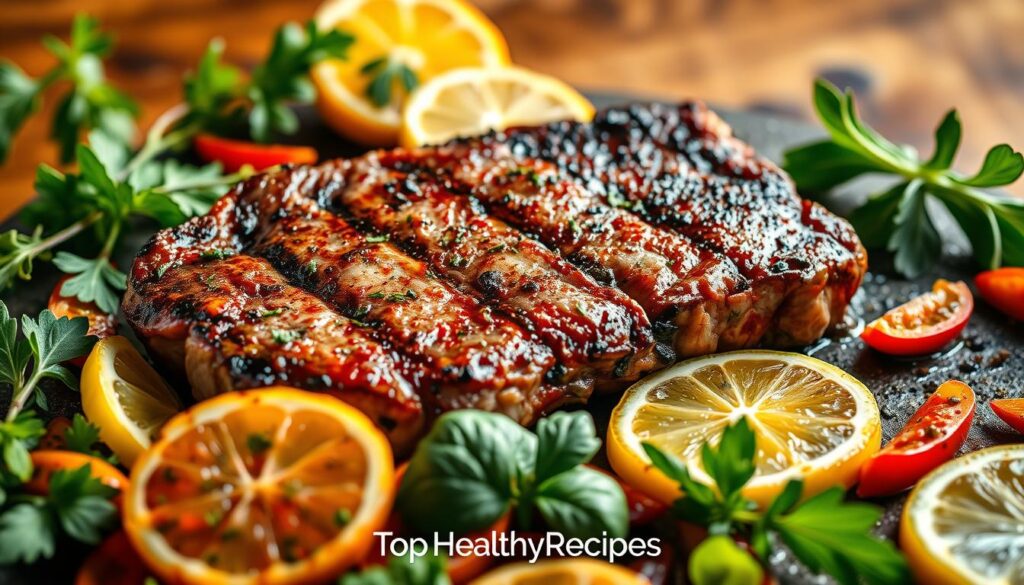
Basting with Butter or Oil
Basting adds luxurious depth to your steak. Try this garlic-rosemary compound butter for restaurant-quality results:
- Mix ½ cup softened butter with 2 minced garlic cloves and 1 tbsp chopped rosemary
- Roll into log shape using parchment paper
- Chill for 30 minutes before slicing into coins
Melt a coin over your steak during the last 2 minutes of grilling. The herb-infused fat creates a glossy crust while keeping the meat juicy.
Finishing Touches: Sea Salt and Herbs
Post-grill seasoning adds textural contrast and flavor bursts. Compare these popular salts:
| Salt Type | Texture | Flavor Impact | Best Use |
|---|---|---|---|
| Maldon | Flaky pyramid crystals | Bright, clean salinity | Surface sprinkling after resting |
| Himalayan | Fine-grained crunch | Subtle mineral notes | Mixed into dry rubs pre-grill |
Pair with fresh thyme or cracked black pepper for layered complexity. Sprinkle herbs immediately before serving to preserve their aroma.
Pairing with Sauces and Condiments
Balance your steak’s boldness with these sauce options:
- Classic Béarnaise: Rich tarragon butter sauce for traditionalists
- Chimichurri: Zesty Argentine blend of parsley, garlic, and vinegar
- Peppercorn Cream: Velvety brandy-infused sauce with cracked pepper
Serve sauces on the side to let guests customize each bite. For quick options, try horseradish cream or bourbon-infused barbecue glaze.
Serving Suggestions for Strip Steak
Make your New York strip steak recipe special with great pairings and presentation. Whether it’s for a dinner party or a cozy night in, these ideas will impress. They mix flavor, texture, and looks perfectly.
Ideal Side Dishes to Pair
Seasonal sides add freshness and contrast to rich, grilled steak. In summer, try grilled asparagus (10-minute prep) or a watermelon-feta salad (15 minutes). For fall, roasted Brussels sprouts with bacon (20 minutes) or maple-glazed sweet potatoes (25 minutes) are great. Winter brings creamy mashed cauliflower (15 minutes) or garlic-sautéed spinach (8 minutes).
Wine Pairings that Complement Strip Steak
Choose wines that match the steak’s bold flavors. Here’s a quick guide to help you pick:
| Wine Type | Flavor Notes | Pairing Tip |
|---|---|---|
| Cabernet Sauvignon | Blackcurrant, oak, tannins | Balances marbled fat in prime-grade steaks |
| Malbec | Plum, dark cherry, smoky | Enhances charred crust from grilling |
Creative Garnishes and Presentations
Steakhouse chefs have tricks to wow guests:
- Arrange sliced steak against the grain at a 45° angle
- Place rosemary sprigs under the meat for aromatic elevation
- Add edible flowers like nasturtiums for color contrast
Drizzle reduced balsamic glaze in zigzag patterns for a touch of class. Serve on warm stone slabs to keep the steak warm during outdoor meals.
Common Mistakes to Avoid
Even the most skilled grillers can make mistakes. A small error can ruin a great steak. Let’s look at three big mistakes and how to avoid them. This way, your next steak will be a hit.
Overcooking Your Steak
Dry, tough steak often comes from leaving it on the grill too long. Strip steak cooks fast because it’s lean. Use a meat thermometer to check for 130°F (medium-rare). Take it off the grill early, as it will get hotter while resting.
If it’s already overcooked, try the sous vide rescue. Seal the steak in a bag with butter or broth. Then, cook it in a water bath at 130°F for 1–2 hours. This method makes the meat tender again.
Neglecting to Season
Salt is essential for a great steak. Skipping seasoning makes flavors dull. Sprinkle kosher salt on both sides 40 minutes before grilling. This lets the salt soak in and boost the juices.
For even seasoning, sprinkle from 12 inches above. This “rain method” prevents clumps. Add pepper after cooking to avoid bitterness from burnt spices.
Using a Cold Grill
A lukewarm grill can’t sear well, making meat gray and steamed. Preheat your grill for 15 minutes on high (450–500°F). For charcoal, wait until coals are ash-white. Test the heat by holding your hand 5 inches above the grates—you should only manage 2 seconds before pulling away.
If your grill can’t get hot, clean the burners or add fresh charcoal. High heat is key to keeping juices in and creating a delicious crust.
Grilling Alternatives for Strip Steak
Grilling isn’t the only way to enjoy a juicy strip steak. You can cook indoors or try new methods. These alternatives give you restaurant-quality results without a grill.
Cooking on a Grill Pan
A cast iron grill pan is perfect for how to cook strip steak on stove. Heat it up until it’s very hot. This creates grill marks and keeps the steak juicy.
Pat the steak dry and season well. Sear it for 4-5 minutes on each side for medium-rare. Let it rest for 5 minutes before slicing.
Broiling Your Strip Steak
Broiling is great for a new york strip in oven. Place the oven rack 4-6 inches below the broiler. Preheat for 10 minutes.
Put the steak on a wire rack over a baking sheet. Broil for 4-6 minutes on each side. Use a meat thermometer to check for 130°F (medium-rare).
Sous Vide Method for Steak Lovers
Sous vide is all about precision. Set your immersion circulator to 129°F for medium-rare. Seal the steak with herbs or garlic, then cook for 1-2 hours.
Finish with a 60-second sear in a very hot cast iron skillet. This adds a caramelized crust.
| Method | Temperature | Time | Best For |
|---|---|---|---|
| Grill Pan | Medium-High | 8-10 mins | Quick stovetop sear |
| Broiling | 500°F+ | 8-12 mins | Oven-centric cooking |
| Sous Vide | 129°F | 1-2 hours | Perfect doneness control |
Each method has its own strengths. Grill pans are great for weeknight dinners. Broiling is perfect when you can’t grill outside. Sous vide is for those who love precision.
Try these techniques with your favorite sides. You’ll never miss the grill.
Troubleshooting Your Grilling Experience
Even the most experienced grillers sometimes run into problems. Whether your grill gets too hot or the heat isn’t even, there are quick solutions. Let’s tackle these common grilling issues together.
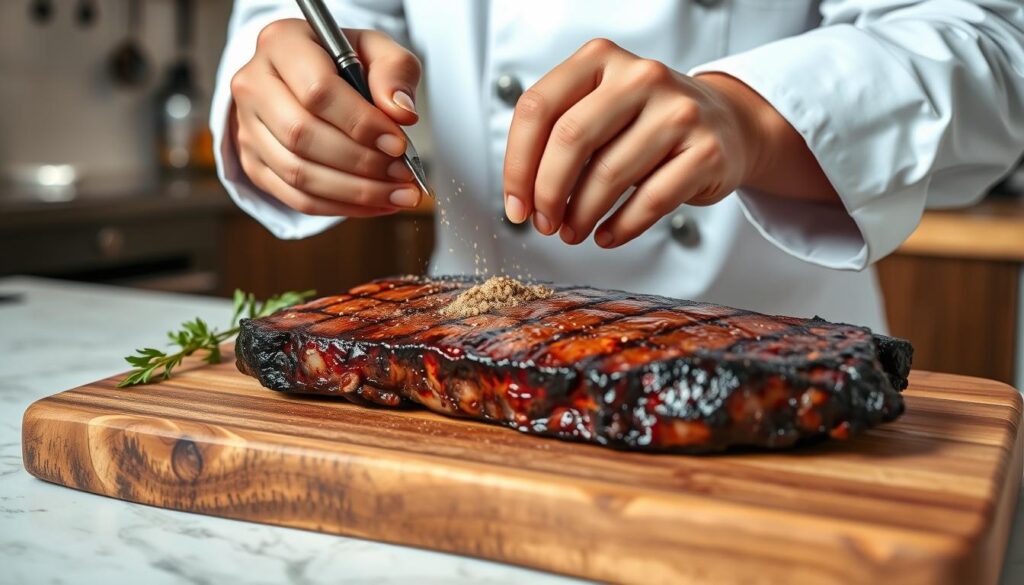
What to Do if Your Grill Is Too Hot
Zone cooking is your best friend here. Move the steak to a cooler part of the grill right away. Put a water pan on the hot side to soak up extra heat and keep temperatures steady. This helps prevent charring and keeps the inside juicy.
Fixing Overcooked Steak Problems
If your NY strip steak gets too dry, slice it thinly and simmer in a demi-glace sauce for 5 minutes. The rich broth makes the meat juicy again, adding flavor. Serve it over mashed potatoes for a nice texture contrast.
Handling Issues with Uneven Cooking
Uneven heat can come from clogged grill grates or uneven fuel. Clean the grates before cooking and turn the steak every 2 minutes. For charcoal grills, spread coals evenly or use a two-zone setup to avoid hotspots.
Regular grill upkeep—like checking burner tubes or replacing old grates—helps avoid uneven cooking. A well-kept grill means your NY strip steak will cook evenly every time.
Storage Tips for Leftover Strip Steak
Properly storing leftover steak ensures you enjoy its rich flavor even days after grilling. Let’s explore how to keep your New York strip fresh, reheat it effectively, and transform it into exciting new meals.
Best Practices for Refrigeration
Cool your steak to room temperature within two hours of cooking. Wrap it tightly in foil or place it in an airtight container to prevent dryness. According to USDA guidelines, refrigerated steak stays safe to eat for 3–4 days.
- Slice leftovers before storing for easier reheating
- Label containers with dates to track freshness
- Separate steak from sides like vegetables or potatoes
How to Reheat Without Losing Flavor
Revive your New York strip in oven settings or try precision methods. This table compares popular techniques:
| Method | Temperature | Time |
|---|---|---|
| Oven | 250°F | 20 minutes |
| Sous Vide | 130°F | 45 minutes |
For oven reheating: Place steak on a wire rack over baking sheet. Add a cup of water below to create steam and prevent toughness.
Creative Dishes for Leftovers
Transform leftover steak into three crowd-pleasing meals:
- Steak & Arugula Salad: Toss sliced steak with peppery greens, cherry tomatoes, and balsamic glaze
- Philly Cheesesteak Sandwich: Sauté onions and peppers, layer with meat, top with provolone
- Breakfast Hash: Combine diced steak with potatoes, onions, and fried eggs
These recipes work well with New York strip in oven-reheated meat. It retains enough moisture for secondary cooking.
Enhancing Your Grilling Skills
Mastering the art of grilling strip steak is more than just the basics. To really improve, try advanced techniques, structured learning, and creative experimentation. This way, every cookout becomes a chance to learn and grow.
Learning From Professional Grill Masters
Certifications from groups like the Kansas City BBQ Society or National BBQ Association offer real training. They teach you how to control temperature, sear like a pro, and present like a champion. Many pitmasters also host workshops at local events. Keep an eye out for these opportunities to learn from the best.
Interactive Online Grilling Classes
Platforms like MasterClass and Udemy have courses for all skill levels. For instance:
- Aaron Franklin’s “Franklin Barbecue Masterclass” teaches about wood and smoke.
- BBQ Champs Academy’s “Steak Perfection” module includes live Q&A sessions with instructors.
Look for classes that let you track your progress. This way, you can see how much you’ve improved.
Experimenting With Flavors
Keep a grilling journal to record your experiments. Track things like:
- Marinade ingredients (e.g., coffee rubs vs. citrus-based blends)
- Wood types (hickory for smokiness, cherry for sweetness)
- Resting times and their impact on juiciness
Try new and bold flavors like a Korean gochujang glaze or Argentine chimichurri. Start with small batches to see what works best. Note your successes and failures for future reference.
Pro Tip: Use a digital thermometer with a Bluetooth app to log temperatures in real time. This helps identify patterns in your grilling process.
Frequently Asked Questions About Grilling Strip Steak
Grilling strip steak can bring up many questions. We’ll answer them with science and practical tips. This way, your cookout will be stress-free and enjoyable.
How Do I Know When It’s Done?
For accurate results, use a meat thermometer. Stick it into the thickest part of the steak, avoiding bone or fat. Here’s a quick guide:
| Doneness Level | Internal Temp (°F) | Visual Clues |
|---|---|---|
| Rare | 120-125 | Bright red center, soft texture |
| Medium Rare | 130-135 | Warm red center, slight firmness |
| Medium | 140-145 | Pink center, springy feel |
Take the steak off the grill 5°F before your target. The heat will finish cooking it while it rests.
Can I Grill Frozen Strip Steak?
Yes, but thawing is better. If you’re cooking frozen:
- Preheat grill to 375°F (medium-low)
- Cook 50% longer than thawed steak
- Flip every 2 minutes to prevent charring
Food safety note: Never refreeze thawed steak. Pat dry frozen surfaces with a paper towel before grilling to avoid flare-ups.
What’s the Best Marinade Recipe?
Here are three marinades that tenderize and add flavor:
- Citrus-Garlic Marinade
Lemon juice (acid breaks down muscle fibers) + olive oil + minced garlic. Marinate 2-4 hours. - Pineapple Teriyaki Marinade
Fresh pineapple (bromelain enzyme softens meat) + soy sauce + brown sugar. Marinate 1 hour max. - Yogurt-Spice Marinade
Plain yogurt (lactic acid tenderizes) + cumin + paprika + black pepper. Marinate overnight.
Always pat steaks dry before grilling. This ensures a good sear. These marinades are great for cooking NY strip steak for the best texture and flavor.
Final Thoughts on Grilling Strip Steak
Learning to grill strip steak is all about technique, patience, and creativity. Whether you use charcoal or a gas grill, success comes from mastering the basics. Start with the best ingredients, control your heat, and let the meat rest. These steps turn a good steak into a memorable meal.
Your Grill-Ready Checklist
Here are the must-haves for your next grill session:
- Pat steaks dry before seasoning
- Preheat grill to 450°F–500°F
- Use a meat thermometer (125°F for rare, 135°F for medium-rare)
- Rest steaks 5–8 minutes before slicing
Grow Your Grill Mastery
Local BBQ competitions, like those by the Kansas City Barbeque Society, are great for learning. Attend events to see the pros in action. Or, take online classes from MasterClass, where chefs like Aaron Franklin teach advanced techniques.
Hosting Made Simple
Plan steak-themed parties with digital tools. Weber’s GrillMaster app helps with planning sides like roasted asparagus and baked potatoes. For wine, try Jordan Cabernet Sauvignon or Stags’ Leap Chardonnay. Set up DIY sauce stations with Sweet Baby Ray’s BBQ Sauce and homemade chimichurri.
Every time you grill strip steak, you get better. Invite friends over for casual cookouts or themed dinner parties. Keep track of your experiments in a grilling journal. Your future self will thank you.
FAQ
How do I know when my strip steak is done?
Can I grill a frozen New York strip steak?
What’s the best marinade for New York strip steak?
How thick should a strip steak be for grilling?
How to cook a New York strip steak on the stove?
What’s the best oven method for New York strip steak?
How long should I rest grilled strip steak?
Gas vs charcoal grill for strip steak – which is better?
How to prevent overcooking strip steak on the grill?
What USDA grade is best for strip steak?
How to achieve restaurant-quality sear on strip steak?
Can I use olive oil for seasoning before grilling?
How to reheat leftover strip steak without drying it?
What wine pairs best with grilled New York strip?
For more cooking tips, stay connected with us. We also recommend the cookbook Skinnytaste Simple: Easy, Healthy Recipes with 7 Ingredients or Fewer
For more Recipes about Steak ?
Did You try our recipe ?
There are no reviews yet. Be the first one to write one.
